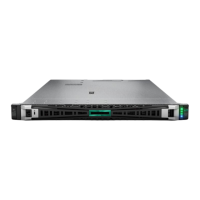Restore Default Manufacturing Settings, this information is cleared, whereas it is retained when you
Restore Default System Settings.
To save a custom default configuration to use during a system restore, use User Default Options. Doing
so saves settings you might otherwise lose.
Procedure
1. From the System Utilities screen, select System Configuration > BIOS/Platform Configuration
(RBSU) > System Default Options > Restore Default Manufacturing Settings.
2. Select Yes, restore the default settings.
3. Reboot the server.
Changing the default UEFI device priority
Use the Default UEFI Device Priority option to change the UEFI device priority that is used when default
system settings are restored. The initial UEFI Boot Order list is created based on the priorities defined in
this option. When the default configuration settings are loaded, the settings from the saved Default UEFI
Device Priority list are used instead of the system or factory defaults.
Prerequisites
User Default Options are configured and saved.
Procedure
1. From the System Utilities screen, select System Configuration > BIOS/Platform Configuration
(RBSU) > System Default Options > Default UEFI Device Priority.
2. Select an entry.
3. Use the + key to move the entry higher in the list. Use the - key to move it lower in the list. Use your
pointing device or the arrow keys to navigate the list.
4. Save your settings.
Saving or erasing user default options
Use User Default Options to save or erase a configuration as the custom default configuration.
Configure the system as necessary and then enable this option to save the configuration as the default
configuration. When the system loads the default settings, the custom default settings are used instead of
the manufacturing defaults.
Procedure
1. From the System Utilities screen, select System Configuration > BIOS/Platform Configuration
(RBSU) > System Default Options > User Default Options.
2. Select an option.
• Save User Defaults
130 Changing the default UEFI device priority

